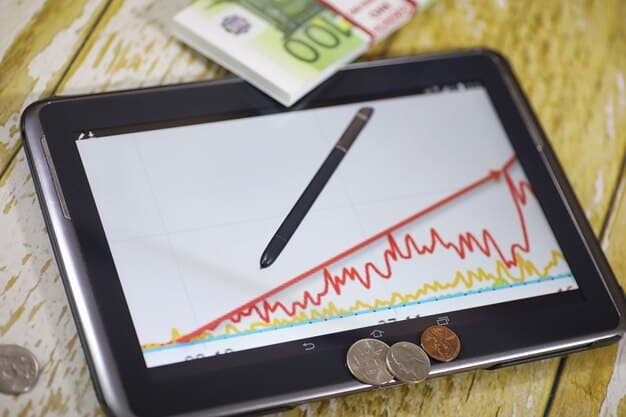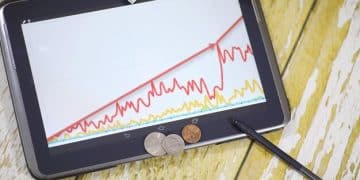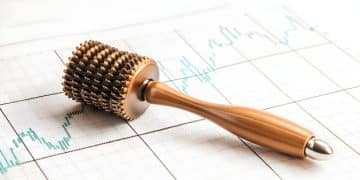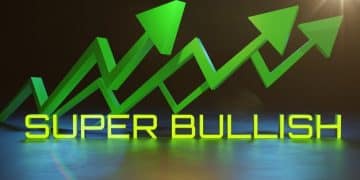Inflation Alert: Understanding CPI’s 3.5% Increase and Its Effects

The latest Consumer Price Index (CPI) report reveals a 3.5% increase, signifying persistent inflationary pressures that affect household budgets and economic stability across the United States.
The recent announcement of a Consumer Price Index (CPI) increase of 3.5% has once again brought inflation to the forefront of economic discussions. This figure, though seemingly minor to some, carries significant implications for households, businesses, and the broader economic landscape in the United States. Understanding the nuances of this latest CPI surge, what drives it, and its multifaceted effects is crucial for navigating today’s economic realities.
Understanding the Consumer Price Index (CPI)
The Consumer Price Index (CPI) is a critical economic indicator, often referred to as a barometer of inflation. It measures the average change over time in the prices paid by urban consumers for a market basket of consumer goods and services. A rise in the CPI signifies that, on average, goods and services are becoming more expensive, eroding purchasing power.
This index is compiled and released monthly by the Bureau of Labor Statistics (BLS). Its primary purpose is to provide a comprehensive measure of inflation, reflecting the cost of living for a typical household. The basket of goods and services is diverse, encompassing everything from food and energy to housing, medical care, and transportation. Periodically, the contents of this basket are updated to better reflect current consumer spending habits.
Components of the CPI Basket
The CPI is not a single, monolithic number; rather, it’s an aggregate derived from changes in prices across various categories. Each category holds a different weight in the overall index, reflecting its importance in the average household budget. For instance, housing costs typically constitute the largest share.
- Housing: This includes rent, owners’ equivalent rent, and lodging away from home. It’s often the largest component and a significant driver of overall CPI changes.
- Food: Covers prices for groceries (food at home) and restaurant meals (food away from home).
- Transportation: Includes costs for new and used vehicles, motor fuel, public transportation, and vehicle maintenance.
- Energy: Encompasses electricity, natural gas, gasoline, and other fuels, which can be highly volatile.
- Medical Care: Covers services like doctor’s visits, hospital stays, prescription drugs, and medical supplies.
Understanding these components helps in deciphering whether inflation is broad-based or concentrated in specific sectors. When the CPI rises by 3.5%, it suggests that the combined effect of price increases across these various categories averages out to that percentage. This metric becomes a vital tool for policymakers, businesses, and individuals alike, guiding decisions on everything from monetary policy to personal budgeting.
Decoding the 3.5% Increase: What Drove It?
The latest 3.5% increase in the CPI is not an isolated event but rather a culmination of various economic forces at play. Pinpointing the exact drivers behind this specific surge requires a closer look at the underlying data and current global and domestic economic conditions. While a single factor rarely tells the whole story, several key contributors likely pushed inflation upwards.
One significant factor often contributing to inflationary pressures is persistent demand exceeding supply in key sectors. Post-pandemic, demand for certain goods and services rebounded sharply, sometimes outpacing the ability of supply chains to keep up. This imbalance inherently leads to price increases as consumers compete for limited resources. Additionally, geopolitical events, such as conflicts or trade disruptions, can impact commodity prices, particularly energy and food, which have widespread effects across the economy.
Key Contributors to the Recent CPI Spike
Analyzing the sub-components of the CPI report reveals specific areas where prices have seen notable increases. These segments often act as leading indicators or significant contributors to the overall inflationary trend.
- Shelter Costs: Housing expenses, including rent and owners’ equivalent rent, have consistently been a major driver of inflation. A tight housing market, coupled with high demand, can push these costs upward, which then cascades into the CPI.
- Energy Prices: Fluctuations in global oil and natural gas prices can directly impact transportation costs (gasoline) and utility bills (electricity, heating). Geopolitical tensions or supply restrictions can lead to sharp increases in this volatile category.
- Rising Labor Costs: In many sectors, businesses are facing increased pressure from rising wages due to labor shortages and a strong job market. While beneficial for workers, these higher labor costs are often passed on to consumers through higher prices for goods and services.
Furthermore, policy decisions can also play a role. Fiscal stimulus measures or significant government spending, while aiming to support economic growth, can inject more money into the economy, potentially fueling demand-pull inflation. Simultaneously, monetary policy, particularly interest rate decisions by central banks, aims to tame inflation by influencing borrowing costs and overall economic activity. The confluence of these macro and microeconomic factors culminates in the aggregate CPI figure, painting a picture of the current inflationary environment.
Immediate Effects on Households and Consumers
A 3.5% increase in the CPI directly translates into a palpable impact on the daily lives of households and individual consumers. This seemingly abstract percentage becomes very real when families notice their paychecks stretching less far and essential goods costing more. The immediate effect is a reduction in purchasing power, meaning that the same amount of money buys fewer goods and services than it did previously.
For the average consumer, this manifests as higher prices at the grocery store, increased utility bills, and more expensive commutes. Discretionary spending, such as dining out or entertainment, often takes a hit as families prioritize necessities. This forces a reallocation of budgets and, in some cases, a compromise on quality of life.
Budgetary Pressures and Lifestyle Adjustments
The rising cost of living puts significant pressure on household budgets, particularly for those on fixed incomes or lower-wage earners who have less flexibility to absorb these increases. This inflationary period necessitates a strategic approach to personal finance.
- Reduced Saving Capacity: As more of one’s income goes towards essential expenses, the ability to save for future goals, like retirement or a down payment, diminishes.
- Increased Debt Reliance: Some individuals or families might resort to credit cards or loans to cover unexpected expenses or maintain their lifestyle, leading to higher debt levels.
- Trade-offs and Prioritization: Consumers are forced to make more difficult choices, often delaying larger purchases or cutting back on non-essential items to manage rising costs.
The psychological impact also should not be understated. Persistent inflation can create a sense of economic insecurity and anxiety, as future costs become less predictable. Consumers may feel a constant squeeze on their finances, leading to a general feeling of being less well-off even if their nominal income remains the same or even increases slightly. This erosion of confidence can lead to changes in consumption patterns and investment behaviors, shaping the broader economic outlook.

Impact on Businesses and Industries
The reverberations of a 3.5% CPI increase extend far beyond individual households, significantly impacting businesses and various industries. For companies, inflation translates into higher operating costs, affecting everything from raw materials and energy to labor and transportation. This creates a challenging environment where profit margins can be squeezed, and strategic decisions become more complex.
Businesses face a delicate balancing act: absorb the higher costs, pass them on to consumers, or find ways to increase efficiency. Each option carries its own set of risks and benefits. Small and medium-sized enterprises (SMEs) often feel the pinch most acutely due to their limited financial buffers and economies of scale compared to larger corporations. Sectors heavily reliant on commodities or energy are particularly vulnerable to inflationary pressures.
Operational Headwinds and Strategic Adjustments
Inflation forces businesses to re-evaluate their entire operational model and pricing strategies. The goal is to maintain profitability and market share while navigating rising input costs.
- Supply Chain Disruptions: Higher costs for raw materials and components, coupled with increased shipping expenses, can lead to disruptions and delays throughout the supply chain.
- Pricing Strategies: Companies must decide whether to raise prices to offset increased costs, risking a reduction in demand, or to absorb costs, potentially eroding profit margins.
- Wage Pressures: As the cost of living rises, employees typically demand higher wages to maintain their purchasing power, adding another layer of cost to businesses.
Furthermore, investment decisions can become more challenging. Uncertainty about future costs and consumer demand can delay expansion plans or capital expenditures. Businesses may also explore innovative solutions to mitigate inflationary effects, such as investing in automation to reduce labor costs, diversifying suppliers to reduce reliance on specific regions, or improving energy efficiency to lower utility bills. The adaptive capacity of businesses in times of inflation dictates their resilience and long-term viability, often leading to a landscape where only the most agile and strategically sound enterprises thrive.
Government and Federal Reserve Responses
In the face of persistent inflation, demonstrated by the 3.5% CPI increase, government bodies and central banks, particularly the Federal Reserve in the U.S., assume a pivotal role. Their primary objective is to maintain economic stability, which includes controlling inflation while fostering sustainable growth and full employment. The interplay between fiscal policy (government spending and taxation) and monetary policy (controlled by the Federal Reserve) is crucial in this endeavor.
The Federal Reserve, as the central bank, utilizes its monetary policy tools to influence interest rates and the money supply, aiming to cool down an overheating economy without triggering a recession. Meanwhile, the government can implement fiscal measures that either exacerbate or alleviate inflationary pressures, often through budget allocations and tax adjustments. A coordinated, well-calibrated response from both is essential to navigate inflationary cycles effectively and mitigate adverse impacts on citizens and businesses.
Policy Tools and Their Implications
Both fiscal and monetary authorities have distinct tools at their disposal, each with its own set of implications for the economy and the trajectory of inflation.
- Interest Rate Adjustments (Federal Reserve): The Fed’s primary tool is adjusting the federal funds rate. Raising rates makes borrowing more expensive, discouraging spending and investment, thereby cooling demand and inflationary pressures. Lowering rates does the opposite.
- Quantitative Tightening (Federal Reserve): This involves reducing the Fed’s balance sheet by selling off government bonds and other securities, which withdraws money from the financial system and can also help rein in inflation.
- Fiscal Policy (Government): This includes government spending on infrastructure, social programs, or tax policies. While sometimes aiming to stimulate growth, excessive spending without corresponding revenue can fuel demand-pull inflation. Targeted tax cuts can also influence consumer behavior.
The effectiveness of these policies hinges on timing and magnitude. A too-aggressive tightening of monetary policy risks a recession, while insufficient action allows inflation to become entrenched. Similarly, fiscal policy needs to be carefully managed to avoid adding to inflationary pressures unnecessarily. Policymakers face the complex challenge of achieving a “soft landing,” where inflation is brought under control without significant economic downturn, reflecting a careful calibration of economic levers in response to evolving market conditions and data, like the recent CPI report.
Future Outlook and What to Expect
The 3.5% CPI increase offers a snapshot of the current economic reality, but the more pressing question for many is what lies ahead. Forecasting inflation is a complex endeavor, influenced by a multitude of domestic and international factors, from geopolitical stability to technological advancements and consumer sentiment. However, understanding potential future trends is vital for individuals and businesses to prepare and adapt effectively.
Economists and analysts frequently debate whether current inflationary pressures are transitory or indicative of a more persistent trend. The Federal Reserve’s stance on monetary policy, coupled with global supply chain dynamics and evolving energy markets, will largely dictate the trajectory of inflation in the coming months and years. While predicting the future with certainty is impossible, we can consider various scenarios based on current information and expert analyses.
Potential Scenarios for Inflation’s Path
Different outcomes for inflation are possible, each with varying implications for the economy. These scenarios depend heavily on how underlying economic forces evolve and how effectively policy measures influence market behavior.
- Gradual Deceleration: This scenario sees inflation slowly returning towards the Federal Reserve’s target of 2% as supply chains normalize, energy markets stabilize, and previous interest rate hikes take full effect. This would be a “soft landing.”
- Sticky Inflation: If wage-price spirals become entrenched or if external shocks (e.g., new geopolitical conflicts, unexpected supply disruptions) persist, inflation could remain elevated for longer than anticipated, requiring more aggressive policy responses.
- Deflationary Risks: Although less likely in the current environment, a severe economic downturn or a significant and sudden drop in demand could theoretically lead to deflation (a sustained decrease in prices), which also poses significant economic challenges.
For consumers, this means continued vigilance in personal finance and adapting spending habits. For businesses, strategic planning around cost management, supply chain resilience, and pricing will remain critical. The economic landscape is dynamic, and continuous monitoring of indicators like the CPI, employment figures, and global commodity prices will be essential for navigating the evolving economic climate. Ultimately, the future outlook will be shaped by the interplay of economic forces, policy decisions, and global events, requiring adaptability from all economic participants.

Strategies for Navigating Inflationary Times
Living and operating in an environment of 3.5% CPI increase, or any elevated inflation, requires proactive strategies for both individuals and businesses. The goal is to preserve purchasing power, protect assets, and maintain financial stability amidst rising costs. Simply hoping for inflation to subside is not a viable strategy; active participation in managing one’s finances and operations is paramount.
For individuals, personal budgeting, seeking opportunities for income growth, and making informed investment decisions become even more critical. For businesses, optimizing operations, managing supply chains efficiently, and adapting pricing are essential for maintaining profitability and competitiveness. Successfully navigating inflationary times means adopting a mindset of resilience and continuous adaptation, rather than reacting to every new economic headline.
Personal and Business Adaptation
Both individuals and businesses have specific levers they can pull to mitigate the effects of inflation and even find opportunities for growth during challenging economic periods.
- For Individuals:
- Budgeting and Expense Tracking: Meticulously track spending to identify areas where cuts can be made or efficiencies gained.
- Income Diversification: Explore opportunities for side hustles or skill development to increase earning potential.
- Smart Investing: Consider investments that historically perform well in inflationary environments, such as inflation-protected securities (TIPS) or real assets like real estate. Review debt strategies, prioritizing high-interest debts.
- For Businesses:
- Cost Control and Efficiency: Implement lean manufacturing principles, negotiate better deals with suppliers, and invest in automation to reduce labor and production costs.
- Dynamic Pricing: Be prepared to adjust pricing more frequently to reflect rising input costs, while carefully monitoring customer sensitivity.
- Supply Chain Resilience: Diversify suppliers, consider nearshoring or reshoring, and build buffer stocks to mitigate future supply disruptions and cost surges.
The ability to adapt quickly and strategically is a key differentiator during inflationary periods. This involves continuous monitoring of economic indicators, understanding market trends, and making decisions based on solid data rather than speculation. While inflation presents challenges, it also fosters innovation and efficiency, pushing both individuals and businesses to optimize their financial and operational practices for long-term sustainability.
| Key Point | Brief Description |
|---|---|
| 📊 CPI Rise | Consumer Price Index increased by 3.5%, indicating persistent inflationary pressures across the US economy. |
| 🏠 Household Impact | Decreased purchasing power, higher cost of living, and budgetary pressures for families and individuals. |
| 📈 Business Challenges | Increased operating costs, squeezed profit margins, and the need for strategic pricing and efficiency gains. |
| 🏛️ Policy Response | Federal Reserve’s monetary tools and government’s fiscal policies aim to control inflation and ensure economic stability. |
Frequently Asked Questions About Inflation and the CPI
A 3.5% CPI increase signifies that, on average, the cost of goods and services urban consumers buy has risen by that percentage over the past year. For your daily expenses, this means that essentials like groceries, housing, and fuel are likely costing more, potentially reducing your purchasing power and requiring adjustments to your budget.
The Federal Reserve primarily combats inflation by adjusting the federal funds rate. Raising this rate makes borrowing more expensive, which in turn cools down demand in the economy, reducing inflationary pressures. They may also employ quantitative tightening, by selling off assets on their balance sheet, to further withdraw money from the economy.
While 3.5% is lower than some recent peaks, it still exceeds the Federal Reserve’s long-term target of 2% inflation, which is generally considered healthy for economic growth. Therefore, 3.5% is higher than what policymakers aim for, suggesting persistent inflationary pressures that warrant continued monitoring and action.
To protect your savings from inflation, consider investments that tend to perform well during inflationary periods. This can include Treasury Inflation-Protected Securities (TIPS), real estate, commodities, or diversified stock portfolios. Avoiding large cash holdings, which lose value due to inflation, is also a common strategy. Consulting a financial advisor is always recommended.
Energy prices are a significant and often volatile component of the CPI. Fluctuations in global oil and natural gas markets directly impact gasoline prices for consumers and utility costs for households and businesses. Due to their foundational role in supply chains and transportation, sharp increases in energy prices can have a cascading effect throughout the economy, contributing notably to overall inflation.
Conclusion
The recent 3.5% increase in the Consumer Price Index serves as a clear reminder of the persistent inflationary pressures currently shaping the economic landscape. This figure is not merely a number; it translates into tangible impacts on household budgets, forcing difficult spending choices, and presenting significant operational challenges for businesses across various sectors. Understanding the intricacies of the CPI, its contributing factors, and its widespread effects is vital for all economic participants. While government and central bank responses aim to steer the economy toward stability, both individuals and businesses must adopt proactive strategies to navigate these inflationary times, from meticulous budgeting and smart investment to optimizing operational efficiencies. The path ahead remains dynamic, requiring continuous adaptation and informed decision-making to foster resilience and financial health in an evolving economic climate.





